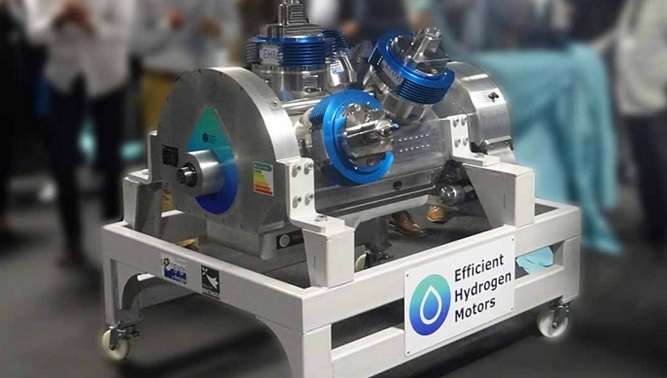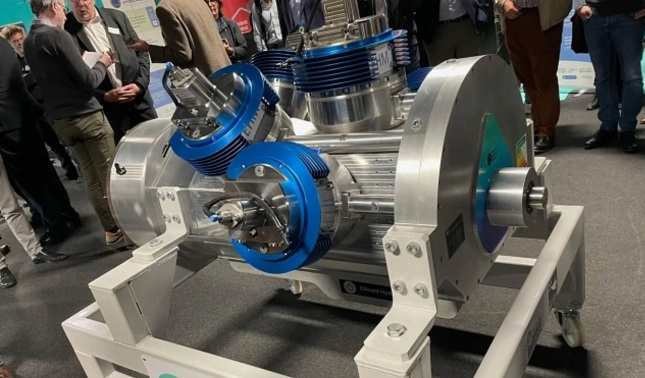A 5-stroke engine powered by hydrogen to replace gasoline and diesel
Hydrogen has the highest specific energy density of all known fuels, followed by nuclear energy. It offers three times more energy per unit of mass than the finest fossil fuels, at 33.3 kWh/kg.

Hydrogen has two uses: it may be used to provide heat or utilized to power fuel cells. The process is carbon neutral since water vapor is the sole consequence in both scenarios. However, hydrogen is difficult to store and transport because of its gaseous state, which necessitates high pressures for practical use.
Similar to a petrol engine, a hydrogen combustion engine runs on hydrogen. In the combustion chamber, hydrogen is introduced and combined with oxygen. This combination produces an explosion upon ignition, powering the pistons.
Utilizing the quantity and energy potential of hydrogen, this engine type offers a feasible substitute for the decarbonization of transportation.
Few explanations- 5 times
The French company Efficient Hydrogen Motors (EHM) has introduced a breakthrough in the field of hydrogen combustion engines: an engine with a five-stroke cycle. Currently, the hydrogen engines on display have the same architecture as the thermal ones, making them nearly instantaneous. Adding a second phase would change this benefit.
The four-stroke cycle that controls petrol and diesel engines consists of intake, compression, combustion (or explosion), and exhaust. The engine pulls in gasoline and air during intake. The potential energy of this combination is then increased via compression. The combustion and explosion that result from the spark from the gasoline spark plug or the compression of the diesel engine itself release energy that drives the pistons. Lastly, during the exhaust phase, the gases produced during combustion are released. This procedure is repeated cyclically to move the vehicle’s wheels to create a linear movement that turns into a circular movement.

The main distinction between a hydrogen engine and a traditional internal combustion engine is that the former runs on hydrogen rather than petrol or diesel. That is the streamlined procedure.
A five-stroke engine has an extra cycle to recover thermal energy from exhaust gases in a second cylinder to increase engine efficiency. The concept is to create an additional phase—the intake, compression, combustion, and exhaust phases—where the engine is driven by the leftover energy while using the same fuel. More performance and efficiency are promised by this technology, particularly in areas like heavy transportation, where the cost-benefit ratio supports its usage.
Beyond noting that this fifth level of technology is tailored for industrial applications and heavy-duty vehicles, EHM needs to go into better detail about it. Five patents cover its direct hydrogen injection system in the combustion chamber, which presents a unique and potentially more effective technique for using hydrogen as energy.
EHM claims its engine is a paradigm shift in clean propulsion technology, offering increased dependability and resolving the pre-ignition issue that plagues four-stroke hydrogen engines. It ensures that its cutting-edge design delivers better energy efficiency and improved performance, with efficiency rates above 50% as opposed to 37% for traditional motors. The 360 HP/265 kW model EHM intends to produce will have this much power.
The commercial objective of the EHM
With the help of the Brittany area, EHM needs to fund €100 million over three years to open a production factory in Châteaulin, Finistère. Prioritizing the development of electric generators based on this engine, the business will also provide solutions for trash trucks, fishing boats, and freight trucks. Eventually, the engine will be used in heavy transport vehicles. The facility is anticipated to create 50 jobs and start manufacturing 3,500 units annually, aiming to reach 9,000 units.
Related Post
- Crazy offers with the Toyota Mirai in California: for $40,000 less and at the price of the Tesla Model 3
- The next 2025 Porsche Panamera will be electric, but it will differ from the sportier Taycan by offering extra space and luxury.
- Bugatti says goodbye to the W16: its next gem will have a V16 block with a hybrid system.
